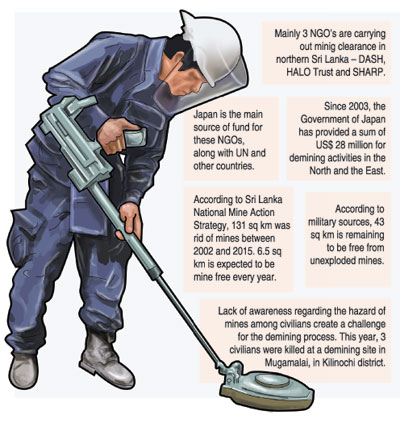News
For the countless jobless, deadly mines are a lifeline
View(s):By Ravi Shankar in Jaffna
They earn about 25,000 rupees a month, but the women of Muhamalai, who are digging up many types of explosives including anti-personnel mines, anti-tank mines and unexploded ordnance, are doing priceless work in the largest minefield in Sri Lanka. Tamil terrorist fighters and Sri Lanka’s military laid thousands of mines in the area during the war years. After combat ended, Devlon Assistance for Social Harmony (DASH), a local NGO began employing many jobless women from the area to neutralise deadly weapons buried by combatants. The hidden killer continues to cause injuries including in children.

Women field staffers involved in the demining process at Muhamalai
DASH, co-founded by Brigadier Ananda Chandrasiri, began operations in 2012 and now employs many women who go about their business of clearing the deadly arsenal scanning every inch of land beneath their feet – one mine at a time in the baking heat. From appearances alone, it is hard to figure out if they are fearful, although they wear protective gear such as vests, visors and boots.
But the reality is that for many, demining is the only job available in a country where millions, especially women, remain jobless. Many who are staring down on death every day in Muhamalai are single mothers from former conflict areas.For Kosala Devi, a mother of three, there is no choice: “Not that I am unaware of the perils of this job. Even my children do not want me to work in a demining site. But the truth is, there is no other job to do in this area.”
Among the NGO’s field staff, 22 percent are females. Demining gives them an opportunity to the earn between Rs 22,000 and Rs 25,000. Most agree that it is a big payday for them.Among the workers are a few former LTTE combatants who have completed the Government’s rehabilitation programme. Some had been conscripted as child soldiers by the LTTE but are now more than 18 years old.
Though in most of the demining sites machinery is used to identify mines, manual work is still needed regardless of the dangers. But Brig Chandrasiri, says workers are trained for a month before they go digging for mines. And yet accidents do happen. A woman field worker says she did suffer from an accident when she pulled the detonator of a mine.
Wearing body armour and a visor, she still crawls into minefields in the shrubs and muddy trenches. “I was lucky that I had only minor injuries and was taken to the hospital immediately. But after that incident I am more vigilant and also I am less afraid of the risk factor in demining,’’ Kosala said.

Land mines and other unexploded devices collected by the DASH at the Muhamalai demining site
Demining is a tedious, laborious undertaking and it takes years. “The mine clearance is slow. A hundred as mines can be laid in a day, but it takes a year to clear,’’ said Brig Chandrasiri. Much has been achieved over the years by many NGOs and the Government.
Military spokesperson, Brigadier Roshan Seneviratna, said: “We expect to make Sri Lanka free from the threat of mines by 2020, if the funding comes in properly.’’ That appears ambitious. Sri Lankan Mine Action Strategy reveals that 6.5 sq km are expected to be cleared every year. In Muhamalai, DASH has cleared only 30 percent of the total confirmed mined area, after six years of work.
According to DASH, more than 700 mines have been extracted from Muhamalai. “Both parties involved in the war never followed any patterns or kept any maps to identify locations of mines,’’ Brig Chandrasiri said. The terrorist group and the army used Pakistan made P4 mines extensively. In addition to DASH, two other NGOs the HALO trust and SHARP are carrying out the mine clearance in northern Sri Lanka, along with the army’s mine clearance team. Presently, Japan is the main source of funding for these NGOs along with UN and other countries.
Foreign funding is essential. According to United Nations estimates, it takes only US$3 (Rs 445.50) to lay a mine and US$1,000 (Rs 148,500) to remove one.
Another challenge faced is the lack of awareness about mined areas among the civilians. This year three civilians were killed in Muhamalai, when they had encroached onto the protected area unknowingly.

| MINE INJURY TOLL EXCEEDS 22,000 | |
| More than 22,000 have suffered in Sri Lanka by the end of 2014, as a result of landmines, data gathered by deminers reveal. Among the 22,171 casualties that year were five deminers compared with one casualty in 2013. There were no deaths in 2014, while 21 people were injured compared with 23 in 2013. In 2014, eight men, five women and three children were among the injured. The majority of injured were from Mullaitivu, says the Landmine and Cluster Munitions Monitor.UNICEF cites reports showing that since the 1980s there were 3,770 recorded amputees among the armed forces, police, and civil defence forces. UNICEF also says there were 21,993 landmine casualties since the 1980s, including 1,419 civilian returnees.Meanwhile, landmine clearance is inching along. From 2002 September last year, an area of 131 square kilometres has been cleared of mines under the Sri Lanka mine action program, official reports show. A report by the Ministry of Prison Reforms, Rehabilitation, Resettlement, and Hindu Religious Affairs, says that as of mid-2016, 10 districts remain contaminated with mines. These are Ampara, Anuradhapura, Batticaloa, Jaffna, Kilinochchi, Mannar, Mullaitivu, Polonnaruwa, Trincomalee and Vavuniya. In these 10 districts, 54 square kilometres remain to be surveyed or cleared, as of April this year.-The Sunday Times |

